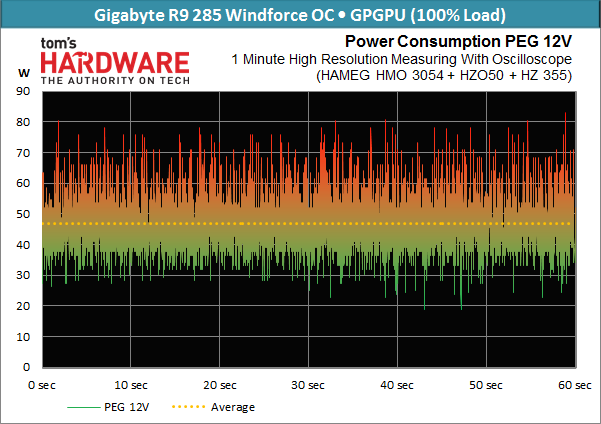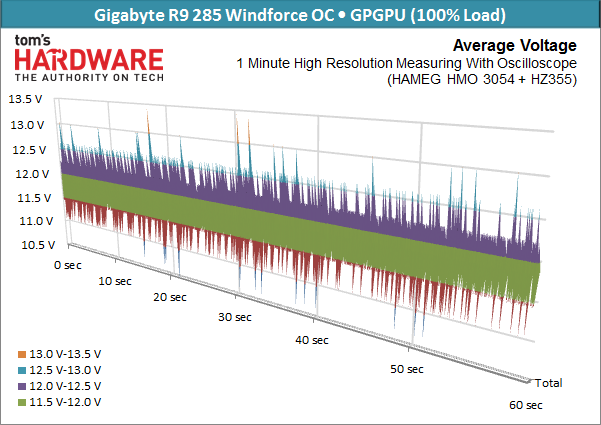AMD Radeon R9 285 Review: Tonga and GCN Update 3.0
On paper, the new Tonga-based R9 285 looks to be slightly slower than the R9 280 it is intended to replace, but there's more than meets the eye.
Why you can trust Tom's Hardware
GPGPU Power Consumption Results
Power Consumption: GPGPU Stress Test
We'll take one step further and push the Gigabyte R9 285 WindForce OC as far as it will go. The resulting 191 W (without changing the power target) are right around where AMD’s TDP said the card would max out. This also shows that the manufacturer’s specifications can generally be trusted, especially since increasing the clock frequency doesn’t change the power draw as long as the other settings are kept the same.
And now lets focus on a perfect minute’s worth of gently smoothed curve.
The measurements at the motherboard slot confirm, once again, that all of the power values we saw fell well within the acceptable range.
Let’s take a look at the individual measurements again in our table.
| Header Cell - Column 0 | Minimum | Maximum | Average |
|---|---|---|---|
| PCIe 12V | 57 W | 175 W | 140 W |
| Motherboard 3.3V | 3 W | 6 W | 5 W |
| Motherboard 12V | 19 W | 83 W | 47 W |
| Graphics Card Total | 87 W | 250 W | 191 W |
List of All Individual Values per Supply Line
Once again, the following gallery shows all power consumption values for each supply line.




Voltages
The average voltage is 11.9 V. Those fluctuations we saw are making an appearance yet again.
The 191 W torture test result is almost the exact TDP as stated by the manufacturer. In light of the higher computing power requirements of OpenCL and DirectCompute, the Gigabyte R9 285 WindForce OC’s performance yield is higher than that of a comparable Kepler-based GeForce graphics card in places. Still, we’re talking about catching up to the competition from an efficiency perspective, not surpassing it. Tonga will probably have trouble going up against Maxwell.
Get Tom's Hardware's best news and in-depth reviews, straight to your inbox.
Current page: GPGPU Power Consumption Results
Prev Page Gaming Power Consumption Results Next Page Temperature and Noise ResultsDon Woligroski was a former senior hardware editor for Tom's Hardware. He has covered a wide range of PC hardware topics, including CPUs, GPUs, system building, and emerging technologies.
-
JeanLuc The idle power consumption numbers are odd, the previous generation cards use less then at idle didn't they? Not that 15 watts is going to break anyone's bank account but its strange nether the less.Reply
Good to see AMD have tackled the noise and temperature issues that have plagued it's previous 28nm cards as well but it's a bit late in the day given that 20nm shouldn't be to far off now. -
gear999 Really nice article guys. I'm impressed by how the 285 actually was able to keep up with the 280. And I'm shocked by the fact that The $250 Nvidia card loses to a $170 AMD card. Thank god I bought a GTX 770 :PReply
Also, on the last page, you guys wrote R7 270X instead of R9, and in the chart it says "Relative to Radeon HD 7950 Boost". Oh, and in the Pros section, it says the 285 has R9 260 like performance?
Thanks for the proofread, fixing it now! :) -
Mike Stewart wow ! at 250$ it actually is a better card even than 280X !! and it was meant for 760....but as it shows here even a 270X is a WAY better card than 760....Reply -
tomfreak Had the tonga 285 come with a 6GHz/7Ghz GDDR5 & 4GB VRAM, the result will be a lot different. Whats with AMD putting on a 5500 memory? facepalm.jpgReply -
srap While this is really a third GCN iteration, showing it as a version number of 3.0 (as in: "Tonga and GCN Update 3.0") makes no sense for me.Reply -
Amdlova some one write this with a .45 acp on the head. I see some error on numbers models etc...Reply
I prefer get a r9 280 and downclock get same results. I can't see the point of this heat on graphics. maybe drivers. OR THIS IS HAWAII XT! Too much Heat! -
Amdlova ReplyI wanted to see the GPU die and OCing results. :(
I think the guys see if they hit the OC the room Will burn! maybe a problem with drivers.
Last time i see that Heat 290x tests. lol! -
Gillerer On the first page, it says "Improvements are always welcome but with the memory interface cut in half compared to the Radeon R9 280,...".Reply
But in fact, the memory interface was cut by a third (384 bit -> 256 bit), not half.
Good point, fixed! Thx.





